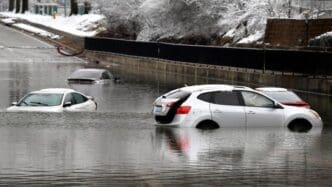A severe storm system has been sweeping across large portions of the U.S. South and Midwest, resulting in at least 16 weather-related fatalities by early Sunday. Forecasters are cautioning that overnight tornado and flash flood warnings could lead to rising waterways in the coming days. Many of the affected regions are already saturated due to a series of severe storms, which have unleashed deadly tornadoes. New warnings were issued overnight in Alabama and Mississippi, along with flash flood advisories for several counties in Kentucky, Mississippi, and Tennessee.
The storm on Saturday brought more torrential rain and flash flooding, exacerbating conditions in the central U.S., rapidly swelling waterways and prompting states of emergency from Texas to Ohio. Tennessee alone reported 10 of the 16 fatalities since the storms began. The National Weather Service has indicated that numerous locations across multiple states are expected to reach “major flood stage,” which could lead to extensive flooding of structures, roads, bridges, and other critical infrastructure.
Tragic incidents have been reported across affected areas. Missouri experienced the death of a 57-year-old man who was swept away after leaving his vehicle during a flood. In Kentucky, flooding claimed the lives of a 9-year-old boy on his way to school and a 74-year-old found inside a submerged vehicle. In Little Rock, Arkansas, a 5-year-old child died in a weather-related incident.
In total, tornadoes earlier in the week destroyed entire neighborhoods, contributing to at least seven deaths. The storms have also severely disrupted air travel, with FlightAware.com reporting 521 flight cancellations and over 6,400 delays within or into the U.S. on Saturday. Interstate commerce may also suffer, as major cargo hubs in Kentucky and Memphis face potential shipping delays due to extreme flooding.
The adverse weather coincides with nearly half of National Weather Service forecast offices experiencing a 20% staff vacancy rate, a result of job cuts under the Trump administration. In Louisville, the Ohio River rose significantly and is expected to continue rising, potentially marking one of the city’s top ten flooding events.
Flash Flood Threat Persists
Flash flood emergencies and tornado warnings continued throughout Saturday across Arkansas, Mississippi, Tennessee, and Kentucky. Eastern Kentucky remained under a flood watch through Sunday morning. Numerous roads in Kentucky were rendered impassable due to floodwaters, fallen trees, or landslides. In Hopkinsville, Kentucky, a brief reprieve occurred as the Little River’s floodwaters receded, but more rainfall was anticipated. Emergency officials ordered mandatory evacuations in Falmouth, Kentucky, as the Licking River posed a significant flooding threat.
In Arkansas, authorities urged residents to avoid travel unless absolutely necessary due to widespread flooding. A railway bridge in Mammoth Spring was washed out, causing a train derailment; however, no injuries were reported.
Causes of Severe Weather
Since Wednesday, some parts of Kentucky have experienced over a foot of rain, with significant rainfall also affecting Arkansas and Missouri. The violent weather is attributed to warm temperatures, an unstable atmosphere, strong wind shear, and abundant moisture from the Gulf of Mexico. Reports of tornadoes have been confirmed in Missouri and Arkansas, causing damage in numerous counties.
In Dyersburg, Tennessee, residents sought refuge in storm shelters, braving the rain with essential belongings. The community has recently endured a tornado that caused extensive damage.
The Human Element Explored
- Communities in the affected regions face prolonged disruptions, including potential displacement due to severe flooding and damaged infrastructure.
- The economic impact from flight cancellations and delays could ripple through industries reliant on timely logistics and supply chains.
- Residents must contend with the emotional toll of repeated natural disasters, prompting community resilience and support networks.
- Infrastructure damage across the storm’s path could lead to long-term rebuilding efforts, affecting local economies and employment.
- Preparation and response to such extreme weather highlight the importance of robust emergency management systems and community readiness.








